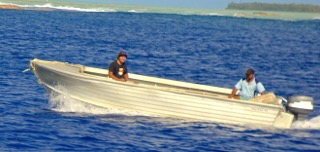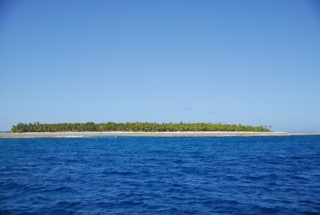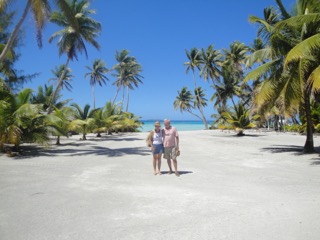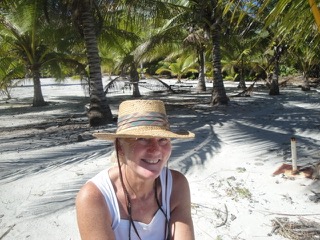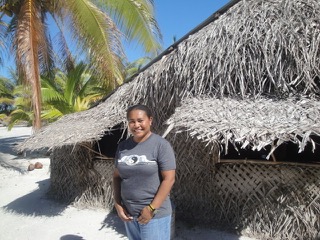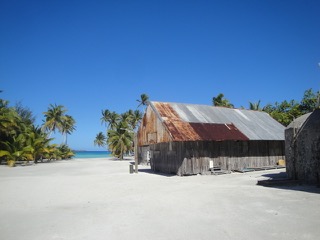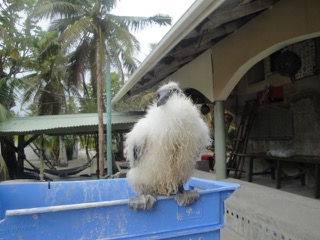Story of a ‘Brummie Lad’ and his island 18° 39’.610S 173° 59’.419W

|
Sent from Tonga, Vavau Island 18° 39’.610S 173° 59’.419W Story
of a ‘Brummie Lad’ and his island For our friends who follow our blog, for whom English is not their mother tongue, we should perhaps first explain that a “Brummie” is a perfectly friendly colloquial term for someone originating from Birmingham and especially somebody who speaks with the strong local dialect of that area. Enough of the English lesson, this story relates to an island a long way from and totally different to the industrial heartland of England. William Masters, as he was known then, was born in Birmingham 1821 and ran away to sea as a ships carpenter. As Birmingham situated in the centre of England is not renowned, for its shipbuilding industry, we guess he was a carpenter who ran away and became a ships carpenter. He
ended up working on a whaler before skipping ship and setting up home in
Penrhyn Island in the Northern Cook Islands. He eventually settled on
Palmerston Island in 1863 with three Polynesian wives! His name had been
changed or misspelt because of the pronunciation, from Masters to Marsters. The
runaway Brummie was an industrious man, he planted about 2000 palm tress,
harvested copra and fathered with his three wives, 21 children! Eventually
there were 54 Marsters grand-children living on the island. William
lived on the island for the rest of his life and died aged 78. William Marsters
gravestone is in the churchyard. Unlike all the other Cook Islands the official
language is English rather than Maori. We’d like to say they all have a Brummie
accent, but that has long gone! Just one family owns the land, and almost everybody living on the island is a Marsters. The land is sub-divided into three sections, according to which of William’s three wives the descendants come from. So we have Marsters-Akakingaro, Marsters-Tepou Tenioi and Marsters-Matavia. The only people we met living on the island, who were not Marsters, was the local nurse Martha who comes from Fiji and Rose, a special-needs teacher, who comes from England. If ever the _expression_, ‘In the middle of nowhere’ is appropriate then Palmerston Island is it. It lies in the middle of The Pacific 200nm (230 miles) from the next small island and 260nm (300 miles) from the capital of the Cook Islands; Rarotonga. There is no airport and the supply boat only calls 3 or 4 times a year. Only 64 people live on the island of whom 26 are children attending the local school. There is an administrative council with representatives from each of the three family groups. Everybody, naturally knows everybody. The island is very small about 1.5 miles long by ¾ mile wide. It is part of an atoll approximately six miles in diameter and although numerous small islands and islets are dotted around the reef, Palmerston is the only island, which is inhabited. The lagoon is teaming with fish and the ocean around the island is a breeding ground for humpback whales. The islanders keep pigs, chickens and goats, have planted fruit trees and also mahogany trees as a source of hardwood timber. They are in many ways self-sufficient. A New Zealand company has erected a large bank of solar cells providing power and a telecommunications satellite antenna provides phone and internet access. We called ahead and were met at the anchorage to the West of the island by our host Edward and his son John. They showed us to one of the mooring buoys and helped us get tied up. We were pleased to be on a mooring as the alternative was to anchor on the edge of a coral cliff. This would have meant that the anchor might not be totally secure and of the wind came up one way you could be blown on to the reef or the other way out to sea. It was late Saturday afternoon and the officials who check you in had finished work for the day. They did not work on Sundays so we agreed to stay on board until Monday morning when we were informed the ‘officials’ would come on board to meet us. We had a relaxed day on Sunday doing odd jobs and catching up with some sleep. On Monday morning no less that 4 officials arrived to check us in, That is nearly 8% of the population! First on board was the environmental health officer, a lady who introduced herself as Martha. The others had to wait until she had been on board and sprayed the interior with the same pesticide that is used on long distance aircraft flights. She completed some paperwork and gave us our health clearance certificate. Then Arthur arrived on board, a very well spoken half New Zealander who was the immigration officer and we found out later was the islands administrator. It was all very polite, very civil but at the same time very correct and the procedures for entering The Cook Islands were followed with precise efficiency. Next was the skiff driver and ‘host’ Edward, who introduced himself now as Chief of Police. Edward completed more paperwork. Finally we spoke to Goody, Edward’s brother, who was the customs officer, answered his questions and received another piece of paper. The whole entry procedure had taken half an hour and cost us 90 US Dollars in fees. The local currency is New Zealand Dollars, but as very few yachts have these on board, they accept US currency. But that $90 was the best, as you will read, we have ever spent to enter a country. You are not permitted to use your own dingy to get ashore. With good reason, the pass through the coral reef is not an easy passage with many shallow places and coral heads sticking up and where ‘local knowledge’ is definitely advisable. When we arrived there was only one other yacht in the anchorage, by the time we had checked in on Monday, there were six yachts including our own. After returning the officials, Edward and his son David in another skiff came and collected the yacht crews. They took us through the tortuous pass and avoiding the many coral heads, across the lagoon. We landed on a beach round the other side of the island. We had arrived on Palmerston. Mid-October,
at the very latest. November until April is the cyclone season. We walked on our own and at times together with the other yachties. We visited Martha, the nurse at her home. She originates from Fiji and took the job of running then local clinic a couple of years ago. She has to cope with everything including delivering a baby girl in March. If it is a serious situation she stabilises the patient until the high-speed police launch arrives from Rarotonga to arrange an evacuation, a long process. She is an amazing person who also screen prints and tie dyes sarongs in her spare time. We were looking at the graveyard next to the church, where the original William Marsters is buried, when Bill Marsters invited us to his house for an ice cream. This was New Zealand ice cream, which he imports 72 litres at a time when the supply boat comes in. Very tasty, very welcome and indeed very generous of him considering the trouble he goes to get the ice cream and the number of visitors he invites. We visited Bill on two occasions and he is very happy to talk about his island, the people, the history and to show people documents or copies of documents he has relating to the island. He has copies of a number of documents from the National Records Office in London relating to a ship owner in the 19th century who disputed William Marsters right to live on the island. He
showed us his collection of old Lister diesel engines that were, before the
solar power plant, used for generating electricity as well as a collection of
all sorts of other equipment. This included a diesel driven blast freezer, used
for freezing fish before the produce was shipped off for sale in the supply
boat. The next day we were collected and seated under the sail having early morning tea. A
call on the radio, Michael had to return to the yacht, something had happened.
I rushed back to the beach where David drove me at high speed in the skiff
across the lagoon and through the pass. I was pleased he seemed to know every
turn and twist of the way. The mooring had broken and Golden Spirit of Islay
was adrift with our own lines attached to what was left of the mooring line.
Luckily the wind was offshore and we were drifting out into The Pacific. Edward
was alongside in the other skiff and had been joined by the skipper of the
American yacht Penn Station. I jumped on board, started the engine and all was
well and under control. Edward reattached the mooring line assuring me that it
was now ‘strong’ and I returned to join Caroline with the story. Strange name Penn Station, a terminus in New York, a bit like naming a British yacht “Euston Station”! We had learned a lot in advance about the island from our friends Colin and Izzi on the yacht Endorphin Beta. They visited the island about 6 weeks ahead of us and carried out some research using the internet. We thank them because their research as helped us write this blog. They met a young lady called Rose who we decided to go and visit. Rose Clark, who is English, has lived on the island for four years. We met her at the local school where she works as a special needs teacher. She has a fascinating story to tell of how a young English woman, originally from Dorset, ended up in Palmerston. Rose’s father was Commander Victor Clark DSC Bar R.N. His amazing life story is that of a war hero, adventurer, writer and circumnavigator. Victor Clark was born in 1908, son of a clergyman and had a relatively privileged childhood before joining The Royal Navy. He was awarded two DSC medals for his outstanding service in the face of the enemy during the Second World War. In 1953 Commander Victor Clark retired from the navy and bought a 33 foot wooden ketch called “Solace” and set off on a circumnavigation. Doing this in 1953 was entirely different to the situation we have today, with many yachts, being equipped to the brim with electronics, GPS Chart Plotters, Satellite phone and e-mail communications systems, HF and VHF transceivers, as well as simple things such as electric lighting and the luxuries of fridges, freezers, hot showers and water-makers and in some cases, although not ours, a washing machine! A 33-foot wooden ketch in 1953 would have been basic, very basic, with paraffin lights, a primus for cooking and a sextant for navigation. He sailed from England to The Caribbean where whilst in Trinidad, a mother persuaded Victor to take her son, named Stanley with him to teach him the art navigation and seamanship. They continued via The Panama Canal across The Pacific, stopping at most of the islands we have stopped at, The Trade Wind route, until they got to Palmerston. Disaster struck, whilst ashore a squall came up and the yacht dragged the anchor and was washed up on the reef. Victor and Stanley were stranded, but with the help of the islanders and using only what was available on the island, they dragged the yacht on to the beach and repaired the damage and after 9 months set sail again and completed the 48,000 mile circumnavigation. Victor never forgot the kindness and hospitality of the people of Palmerston and sent Christmas parcels every year. Victor went on as master of sailing schooners including The Outward Bound Prince Louis and later the 380 ton schooner Captain Scott. He retired in his mid sixties. Stanley once back in The Caribbean, got his masters ticket and started a shipping company. He is now a wealthy man living in St. Lucia. Commander Victor Clark wrote and had two books published: "On
the Wind of a Dream - the Saga of the Solace" and ”Disaster and Triumph”. But life was not over for Victor Clark, at the age of 68 he married and fathered two daughters, the youngest, his daughter Rose was born when he was 72! Rose told us it was wonderful having an older father as he had so much time to spend with them and took long walks with them, well into his eighties. Victor Clark died in 2005 aged 97. His daughter Rose wanted to scatter his ashes on Palmerston and so she arrived four years ago. Some of the locals remembered her father and helped with the arrangements for a memorial stone to be placed in the grave-yard next to the grave of his friend who helped him so much with the repair of his yacht. Rose learned that an 8 year old girl had not started school because of difficulties. She agreed to start work at the school as a special needs teacher, something that was badly needed. Rose who has been on the island four years and now in her mid-thirties wants to have her own family one day and has decided to go back to the UK at the end of this year. Rose is writing a book about her story and life on Palmerston, one that we look forward to reading. And so ends our story of Palmerston Island, its history and some of all the people who live there, who we would very much like to thank. It was a privilege to visit and one we shall always remember. We set sail, crossed The International Date Line and arrived in Tonga on 15 September. Michael
& Caroline Golden
Spirit of Islay
|
